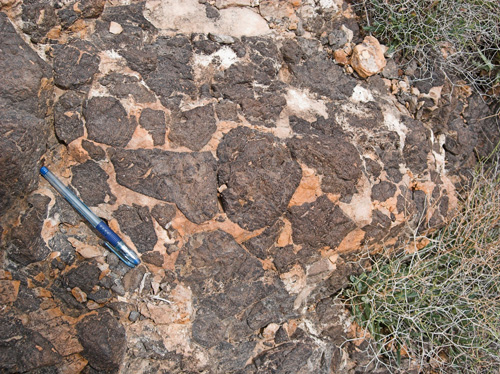The outcrop that I gave you to ponder on Friday is pretty strange, but I can assure you that this isn’t a wall:

Most of you correctly guessed that the dark fragments are composed of a mafic (basalt-esque) igneous rock, but the nature of the intervening orange-weathering and crumbly matrix has been the cause of some puzzlement, as it looks like (and is) more sedimentary in nature. Probably the most important clue was spotted by Christie who noticed that the matrix fills in small gaps and fractures in the larger clasts, which you might not expect to happen so efficiently if the gaps in a volcanic breccia had been filled in by later sedimentation; instead, it seems more suggestive of intrusion of the basalt into pre-existing sediment. More specifically, the basaltic lava was intruded into wet, unconsolidated sediment, which allows interaction and a sort of mixing, although the relative viscosities of the lava and the sediment are so different that you still end up with distinctive, sharp edged chunks of basalt held within an altered sedimentary matrix.
This sort of deposit is known as a peperite, and I photographed this particular one on a trip to southeastern Spain a couple of years ago. I don’t just have Archean rocks in my photography library, you know! My little excursion back into my archives was partly inspired by the last week’s geoblogospheric discussions of culling and reanimating geological words; I’ve always liked the sound of ‘peperite’; it’s suitably explosive sounding for this sort of deposit. Apparently it comes from the fact that these deposits resemble ground pepper, although I’m not so convinced about that…
More on peperites here (a recent review paper), here and here.



Comments (4)